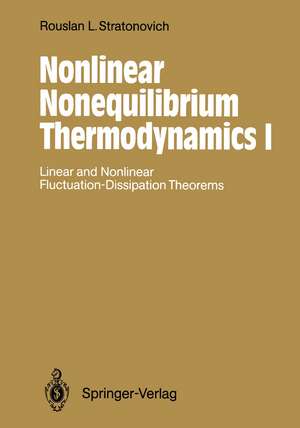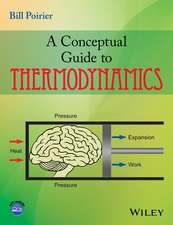Nonlinear Nonequilibrium Thermodynamics I: Linear and Nonlinear Fluctuation-Dissipation Theorems: Springer Series in Synergetics, cartea 57
Autor Rouslan L. Stratonovichen Limba Engleză Paperback – 16 dec 2011
Din seria Springer Series in Synergetics
- 15%
 Preț: 653.14 lei
Preț: 653.14 lei - 17%
 Preț: 430.21 lei
Preț: 430.21 lei - 17%
 Preț: 495.47 lei
Preț: 495.47 lei -
 Preț: 392.37 lei
Preț: 392.37 lei -
 Preț: 396.02 lei
Preț: 396.02 lei -
 Preț: 400.10 lei
Preț: 400.10 lei -
 Preț: 391.02 lei
Preț: 391.02 lei - 15%
 Preț: 641.38 lei
Preț: 641.38 lei - 18%
 Preț: 739.00 lei
Preț: 739.00 lei - 15%
 Preț: 645.60 lei
Preț: 645.60 lei - 15%
 Preț: 637.75 lei
Preț: 637.75 lei - 18%
 Preț: 727.31 lei
Preț: 727.31 lei - 20%
 Preț: 481.77 lei
Preț: 481.77 lei -
 Preț: 398.15 lei
Preț: 398.15 lei - 18%
 Preț: 742.97 lei
Preț: 742.97 lei - 15%
 Preț: 647.40 lei
Preț: 647.40 lei -
 Preț: 416.64 lei
Preț: 416.64 lei -
 Preț: 397.76 lei
Preț: 397.76 lei -
 Preț: 391.99 lei
Preț: 391.99 lei - 15%
 Preț: 644.49 lei
Preț: 644.49 lei -
 Preț: 386.99 lei
Preț: 386.99 lei - 20%
 Preț: 574.08 lei
Preț: 574.08 lei -
 Preț: 387.58 lei
Preț: 387.58 lei - 15%
 Preț: 533.53 lei
Preț: 533.53 lei -
 Preț: 396.02 lei
Preț: 396.02 lei -
 Preț: 390.25 lei
Preț: 390.25 lei -
 Preț: 392.37 lei
Preț: 392.37 lei -
 Preț: 396.40 lei
Preț: 396.40 lei -
 Preț: 408.16 lei
Preț: 408.16 lei - 18%
 Preț: 1116.09 lei
Preț: 1116.09 lei -
 Preț: 397.76 lei
Preț: 397.76 lei - 18%
 Preț: 971.64 lei
Preț: 971.64 lei - 15%
 Preț: 644.30 lei
Preț: 644.30 lei -
 Preț: 386.81 lei
Preț: 386.81 lei -
 Preț: 398.15 lei
Preț: 398.15 lei
Preț: 896.70 lei
Preț vechi: 1093.53 lei
-18% Nou
Puncte Express: 1345
Preț estimativ în valută:
171.59€ • 183.48$ • 143.06£
171.59€ • 183.48$ • 143.06£
Carte tipărită la comandă
Livrare economică 18 aprilie-02 mai
Preluare comenzi: 021 569.72.76
Specificații
ISBN-13: 9783642773457
ISBN-10: 3642773451
Pagini: 384
Ilustrații: XVI, 361 p.
Dimensiuni: 170 x 242 x 20 mm
Greutate: 0.61 kg
Ediția:Softcover reprint of the original 1st ed. 1992
Editura: Springer Berlin, Heidelberg
Colecția Springer
Seria Springer Series in Synergetics
Locul publicării:Berlin, Heidelberg, Germany
ISBN-10: 3642773451
Pagini: 384
Ilustrații: XVI, 361 p.
Dimensiuni: 170 x 242 x 20 mm
Greutate: 0.61 kg
Ediția:Softcover reprint of the original 1st ed. 1992
Editura: Springer Berlin, Heidelberg
Colecția Springer
Seria Springer Series in Synergetics
Locul publicării:Berlin, Heidelberg, Germany
Public țintă
ResearchCuprins
1. Introduction.- 1.1 What Is Nonlinear Nonequilibrium Thermodynamics?.- 1.2 Early Work on Nonlinear Nonequlibrium Thermodynamics.- 1.3 Some Particular Problems and Their Corresponding FDRs: Historical Aspects.- 2. Auxiliary Information Concerning Probability Theory and Equilibrium Thermodynamics.- 2.1 Moments and Correlators.- 2.2 Some Results of Equilibrium Statistical Thermodynamics.- 2.3 The Markov Random Process and Its Master Equation.- 2.4 Infinitely Divisible Probability Densities and Markov Processes.- 2.5 Notes on References to Chapter 2.- 3. The Generating Equation of Markov Nonlinear Nonequilibrium Thermodynamics.- 3.1 Kinetic Potential.- 3.2 Consequences of Time Reversibility.- 3.3 Examples of the Kinetic Potential and of the Validity of the Generating Equation.- 3.4 Other Examples: Chemical Reactions and Diffusion.- 3.5 Generating Equation for the Kinetic Potential Spectrum.- 3.6 Notes on References to Chapter 3.- 4. Consequences of the Markov Generating Equation.- 4.1 Markov FDRs.- 4.2 Approximate Markov FDRs and Their Covariant Form.- 4.3 Application of FDRs for Approximate Determination of the Coefficient Functions.- 4.4 Examples of the Application of Linear Nonequilibrium Thermodynamics Relations.- 4.5 Examples of the Application of the Markov FDRs of Nonlinear Nonequilibrium Thermodynamics.- 4.6 H-Theorems of Markov Nonequilibrium Thermodynamics.- 4.7 Notes on References to Chapter 4.- 5. Fluctuation—Dissipation Relations of Non-Markov Theory.- 5.1 Non-Markov Phenomenological Relaxation Equations and FDRs of the First Kind.- 5.2 Definition of Admittance and Auxiliary Formulas.- 5.3 Linear and Quadratic FDRs of the Second Kind.- 5.4 Cubic FDRs of the Second Kind.- 5.5 Connection Between FDRs of the First and Second Kinds.- 5.6 Linear and Quadratic FDRs of the Third Kind.- 5.7 Cubic FDRs of the Third Kind.- 5.8 Notes on References to Chapter 5.- 6. Some Uses of Non-Markov FDRs.- 6.1 Calculation of Many-Time Equilibrium Correlators and Their Derivatives in the Markov Case.- 6.2 Examples of Computations of Many-Fold Correlators or Spectral Densities and Their Derivatives with Respect to External Forces.- 6.3 Other Uses of Nonlinear FDRs.- 6.4 Application of Cubic FDRs to Calculate Non-Gaussian Properties of Flicker Noise.- 6.5 Notes on the References to Chapter 6.- Appendices.- A1. Relation of Conjugate Potentials in the Limit of Small Fluctuations.- A2. On the Theory of Infinitely Divisible Probability Densities.- A2.1 Justification of the Representation (2.4.9) Subject to (2.4.10).- A2.2 Example: Gaussian Distribution.- A3. Some Formulas Concerning Operator Commutation.- A5. The Contribution of Individual Terms of the Master Equation.- A6. Spectral Densities and Related Formulas.- A6.1 Definition of Many-Fold Spectral Densities.- A6.2 Space—Time Spectral Densities.- A6.3 Spectral Density of Spatial Spectra and Space—Time Spectral Density.- A6.4 Spectral Density of Nonstationary and Nonhomogeneous Random Functions.- A7. StochasticEquations for the Markov Process.- A7.1 The Ito Stochastic Equation.- A7.2 Symmetrized Stochastic Equations.- References.








